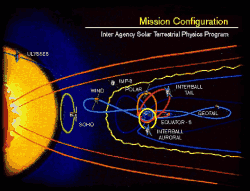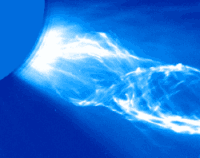Observing Sun-Earth
Connections
by Dr. Daniel N. Baker
Univ. of Colorado, Boulder
 |
| |
The fleet of spacecraft which compose the ISTP
program. Click here for a larger
image. Image courtesy the ISTP program. |
|
Humankind has been fascinated since the dawn of recorded history with the
Sun and its relationship to Earth. Virtually all civilizations have speculated
about the place of our planet in the realm of the solar system and the stars
of our galaxy. Only within the past few hundred years - since Copernicus -
has there been acceptance of Earth revolving around the Sun and only since
the time of Galileo has the changing face of the Sun been known. The role of
the Sun in driving disturbances in Earth's magnetic field has come to be appreciated
within the last century or so.
Thus, human understanding of solar-terrestrial relationships, though having
a history of perhaps five thousand years or more, has proceeded at a painfully
slow pace. Just since the beginning of the space age have we come to a relatively
clear picture of the nature of solar variability and how this variability affects
Earth. Astronomical observations make clear that our Sun is like many variable
stars and so our Sun-Earth system is the physical prototype for stellar systems
throughout the cosmos.
Rather remarkably, human technology on Earth has developed
in close step with our evolving appreciation of the Sun's influences. Mankind
is now using a web
of electrical and communication links that literally gird Earth. We also employ
a vast array of spacecraft around Earth that give us nearly instantaneous communication,
exact position information, knowledge of approaching weather systems, and military
intelligence that makes the world safer for all of us. Every one of these human
technologies can be adversely affected by disturbances in the solar-terrestrial
environment.
 |
| |
An eruptive prominence captured by the SOHO spacecraft. More... |
|
We now know in general terms that our Sun reaches a maximum of
activity every 11 years. As it reaches this state of coronal disturbance, the
Sun is capable
of expelling huge "plasmoids" of material (called coronal mass ejections - CMEs)
which can move outward from the Sun at more than 1000 km/s. The shock waves preceding
such plasma structures can accelerate particles to huge energies sometimes over
one hundred million electron volts. If the shock waves and CMEs strike Earth's
magnetosphere, they can initiate huge geomagnetic storms that can thoroughly
disrupt power systems, communication links, and the constellations of operational
spacecraft on which our societies increasingly rely. The appreciation of CMEs
as the agents of such profound solar disturbances of Earth and its environs has
only come about in the past few years: This "paradigm" shift has had a far- reaching
impact on how we think about solar-terrestrial relationships.
Given a many thousand-year wait to have the tools to study
the Sun, Earth, and our place in between, we now have a most remarkable situation
presented
to us. The International Solar-Terrestrial Physics (ISTP) program has put into
place the most astounding array of spacecraft and ground facilities ever conceived
of for studying the space environment. There are exquisitely sensitive telescopes
in space examining the Sun's many layers. There are spacecraft measuring the
hot, high-speed plasmas flowing over Earth from the expanding solar corona.
There is an unprecedented armada of spacecraft within Earth's magnetosphere
examining continuously all facets of the plasmas which ebb and flow as the
Sun buffets our geospace environment. There is even an international web of
ground stations that are recording quite exactingly the magnetospheric and
ionospheric signatures of the ever-changing interaction of the variable Sun
with our terrestrial environment. Humankind has never before had a "Great Observatory" of
such power, precision, and completeness to study our most important star -
the Sun - and our most important planet - Earth.
Perhaps ironically - certainly fortuitously - the tools offered
to us by ISTP have fallen into place just as we are beginning a new solar
cycle - Number
23 in the international parlance. As measured by Sunspot number, this next
solar maximum - probably to be reached in the year 2001 - will most likely
be a large one. It may be the equal of the strongest solar maximum that has
been experienced in the modern era. This would mean that solar disturbances
of great power and destructive potential may be on their way to the geospace
domain. It is an historic confluence of immense importance that the ISTP armada
is in place now and is operating flawlessly as the "Solar Maximum 2001" approaches.
We have a possibility - perhaps never to be repeated - to study all aspects
of the solar maximum and its consequent effects on the near-Earth environment.
It is an epochal occurrence that for modest costs, the extended operation of
ISTP and affiliated spacecraft can give us the scientific view and the practical
knowledge that we need to finally understand the disturbed Sun and the consequently-disrupted
geospace environment. The extended ISTP program provides us with an opportunity
to revolutionize our understanding of solar-terrestrial physical processes. |